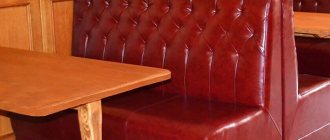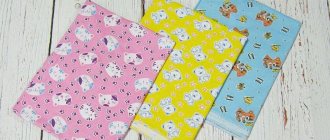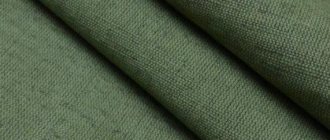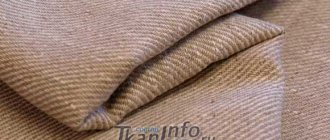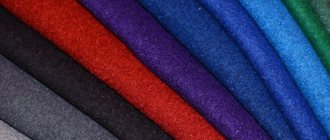Felix
3312 0 0
Felix October 30, 2018Specialization: philological education. 20 years of experience as a builder. Of these, for the last 15 years he led a team as a foreman. I know everything about construction - from design and zero cycle to interior design. Hobbies: Vocals, psychology, quail breeding.
Over time, the upholstery of the chair wears out and has to be reupholstered.
Greetings, my dear readers.
Sooner or later, the upholstery of your favorite chair will wear out. It is bursting at the seams, holes appear here and there, and the fabric pattern fades. The seat becomes unaesthetic and no longer decorates the room.
The best way out of this situation is to repair the chair. Or rather, its constriction. You can do it yourself if you follow the tips I give you.
Office chair upholstery material
The upholstery should be durable and pleasant to the touch, combined with the surrounding interior
Let's look at several main types of upholstery... The upholstery material for office chairs can have different characteristics, which, of course, affects the price of the chair.
Textiles are considered the simplest material, which is why products using them are affordable. Textile Features:
- withstands mechanical stress well, which is very important in an office environment (frequent use)
- easy to clean with a brush
- features a wide selection of colors
Microfiber is a fabric that combines practicality with bright colors.
- microfiber is very pleasant to the touch, velvety
- perfectly ventilated, resistant to dirt
- eliminates the possibility of static electricity
Thanks to these properties, microfiber is used not only in the upholstery of staff chairs, but also for some models of executive chairs.
Staff chairs
Executive chairs
Chairs for visitors
Finally, COW class leather is a natural covering that, thanks to special processing, retains the natural pattern of the upper layers.
This leather is used in the most prestigious models of executive chairs. In addition to comfort, such a chair will bring you status.
Go to our catalog of office chairs and make your desired purchase today!
Do-it-yourself reupholstery of chairs and armchairs
Furniture, like all other things, gradually deteriorates: it begins to wobble, creak, and the upholstery wears out. It is not at all necessary to immediately run to the store - with some effort, old furniture can be restored. Moreover, things in the style of the 60-70s are now in trend. This article will talk about how to reupholster a chair, what materials to use, how and what to do. The technique is also suitable for reupholstering chairs.
Procedure for reupholstering a chair
- 3.1 How to reupholster a chair: tighten the straps
- 4.1 How to fasten and with what force to tighten
The restoration of chairs can be divided into a sequence of actions. Each of the points requires explanation, but the general algorithm of actions can be summarized in a few dozen words:
- Remove the upholstery and soft part.
- Disassemble the frame into its components.
- Assess the condition of the frame, check the connections. Unstable connections should be disassembled, cleaned, and re-glued.
To make a restored chair comfortable, you need to correctly calculate the thickness of the layers.
- If necessary, remove the old coating (paint or varnish) from the legs, back, frame and apply a new one.
- Update the seat base.
- Lay and secure elastic materials that provide softness.
- Cover with fabric.
- If you have pets, it is best to reupholster upholstered furniture: Flock. It is smooth, without loops. So the claws are difficult to catch and damage is usually minimal. But not everyone likes the feel of it.
- Microvelour and velor. Also smooth fabrics with fine pile (not loops), the claws simply slide.
This is what the flock looks like
- For animals with long hair, microvelor is better - it is easier to clean.
Now you know in general terms how to reupholster a chair. But there is something to be said for each point - there are many different tricks that will make the job easier and the result more attractive.
Soft pie: materials, thickness
Before reupholstering a chair, you will have to study some information about what exactly to use when restoring a chair or armchair. Please note that you can use not only the materials listed in this paragraph. We have described the most common, synthetic, inexpensive, with acceptable characteristics. If desired or necessary, you can use natural analogues - copra in mats or rolls, batting, dried sea grass, horsehair, burlap and other materials that are exotic today and once traditional.
Most common materials
What materials are needed to reupholster a chair?
When restoring a chair or armchair, foam rubber or polyurethane foam (PPU) is used for the soft part. We are talking about foamed polyurethane foam, not sheet. There is also furniture latex. It and polyurethane foam differ from foam rubber to the touch. They are more like rubber (latex is generally like rubber); when stretched/compressed, they tend to return to their previous shape.
To be soft enough, the density of these materials should be 30-35 kg/m³. Foam rubber and polyurethane foam are sold in large sheets - the minimum size is 1*2 meters. So that's enough for more than one chair. Latex is usually available in some standard sizes, but is most often made to order.
Different thickness, density, rigidity, different manufacturing technologies
What is better to use for upholstering chairs - foam rubber, latex or polyurethane foam (PPU)? If we talk about quality and durability, then latex or polyurethane foam is better. They will last up to ten years or more without signs of wear, they absorb better and wear out less. The best of this pair is latex, but it is much more expensive than even polyurethane foam, not to mention foam rubber. Therefore, if you are on a limited budget, choose foam rubber. If durability is important - polyurethane foam or latex.
Now on the thickness of these materials. For the back, a thickness of 3-5 cm of foam rubber/PPU/latex is sufficient, depending on the degree of desired softness/hardness, but for the seat it is better to use materials with a thickness of 7-8 cm or more. If the base is solid - made of plywood, without springs or tapes - a thickness of 10 cm is needed. Otherwise the base will be felt.
The three most common materials are foam rubber, polyurethane foam and latex.
A padding polyester is laid on top of the foam rubber. Its thickness is small - 1 cm in a free state or so. It’s easier to navigate by density: 150-200 g/m². This layer is needed so that the foam/PPU/latex rubs less. This way, restored upholstered furniture will last longer.
If you want the chair or armchair you have reupholstered to last longer, another layer of spunbond is stretched over the padding polyester - this is a non-woven material made from a polymer melt using a spunbond method. Spunbond costs very little, but significantly extends the life of the seat. This layer is found in expensive furniture and increases durability (foam rubber/sintepon does not rub) and comfort of use (upholstery fabric does not fidget). A possible disadvantage is the accumulation of static electricity. But this is observed only when natural wool or silk is used in upholstery.
How to cut and fasten
The foam is cut to fit the size of the seat. The easiest way is to make a template at the initial stage: attach a sheet of cardboard to the seat, trace it and cut it out. This template will be needed more than once, so it’s better to make it.
It’s better to make a template right away, especially if you will be dragging several identical chairs
We cut out foam rubber and padding polyester strictly according to the template. In some cases, it is worth making it wider and longer by 3-5 mm so as not to feel the edges of the base. The cut foam rubber is glued to the base using furniture glue. There is a special glue in a can for foam rubber. It is more convenient to use, but it is not easy to find everywhere.
The padding polyester is laid on top - one side is more “rough”, so we place it on the foam rubber/PPU/latex, level it and smooth it with our hands. After this, it is problematic to separate the laid layers (you can try). If this method does not seem reliable enough to you, you can glue the connection by applying a mesh of suitable universal glue or the same glue for foam rubber.
Latex is usually made to order, so the edges are rounded for greater convenience.
One point: if the base of the chair is not rigid - springs, tapes, a snake - the glue you should use is not the one that forms a hard crust after drying, but the one that remains elastic.
If you decide to also use spunbond, it must be cut out with a margin, attached with staples to the base, evenly straightened and stretched. You should not pull too hard - the material is non-woven and is easily damaged. It just needs to lie without folds. Carefully trim the excess to the level of the chair/chair frame.
How to cover a chair: fabrics, stretching
Before you reupholster the chair, you will have to find fabric. And it’s not as simple as it seems: there are not just a lot of upholstery fabrics, but a lot. Moreover, it is often problematic to outwardly distinguish one material from another: not every professional can distinguish artificial suede and some types of microvelor; chenille and jacquard are similar, and sometimes velor is very similar to flock. Nevertheless, you need to have at least the slightest idea about which upholstery fabric is best for upholstering a chair or armchair.
Only one collection from one manufacturer
First of all, decide on the color scheme and type of fabric surface (hairy or smooth). Otherwise you will get confused. Otherwise, you will have to choose “by touch.” Tactile sensations should be pleasant - the chair should be re-stretched so that it is pleasant to use. In summer you will have to touch the upholstery with leather. So this is an important selection criterion. Well, then, let's talk about the types of fabrics and their areas of application:
Other fabrics can also be used if you like them. But they are less practical than those listed above. In any case, you need to pay attention to the density of the fabric. Normal upholstery fabric should have a density of at least 200-250 g/m², as well as high abrasion resistance (15-20 thousand abrasion cycles). These characteristics can be found in the fabric specification or checked with the seller.
How to reupholster a chair: tighten the straps
You usually don’t need to sew anything for the back or seat of a chair. All you need to do is cut out a piece of fabric of a suitable shape with allowances for stretching. Next we proceed like this:
How to reupholster a chair: stretch the fabric evenly to avoid wrinkles
The main thing is uniform tension without folds. The fabric is usually secured with staples, placing them at a distance of 3-5 cm from each other. The staples hold the fabric quite well and do not pierce it. If there are signs that they will break through the surface, you need to reduce the force of the impact.
The second option is to use small cloves. A thick tape is needed under them - just so as not to tear the fabric. Nails are a good solution, but they take more time to reupholster the chair. When using nails, they should not be too long so that they do not stick out from the back side and tear the foam.
Base with straps or snake spring: features
Chairs and armchairs can be made with a wooden frame to which ribbons or a snake spring are attached. For very old chairs/armchairs, the bands may be inelastic - just a thick strip of tarpaulin or similar material; new chairs are made with bands made of synthetic material with “rubber bands”. They are attached to the frame using nails (old furniture) or staples (modern). When fastening with nails, a strip of thick fabric is laid under the fasteners; usually nothing is placed under the staples.
Old chair with canvas strips
When restoring a chair or armchair, it is advisable to use a tape of the same width or close to it. This way it will be possible to maintain the number of transverse and longitudinal stripes. This is if the previous “load-bearing” capacity of the seat suited you. If it was uncomfortable, you can either increase the width of the belts or add more stripes. Or you can do both at once.
The normal distance between the tapes is about 30 mm. Maybe a little more/less, but not much more.
You can use either elastic furniture tape or simply dense tape, such as slings or tow straps. The elastic one will “play back” when landing, the hard one will not. But this does not mean that sitting will be uncomfortable. Softness is provided by foam rubber and related materials, and tapes/springs only soften the fit. Therefore, if you have an old chair or armchair with springs, and they need to be restored, it is easier and cheaper to replace them with ribbons.
In terms of softness of landing, they will be a little stiffer, but not so much that it would be worth bothering with re-tensioning the springs. If desired, you can install snake springs. They also provide elasticity, albeit less than traditional ones.
Springs can also be like this - this is a “snake”
How to fasten and with what force to pull
The straps are attached to the frame, approximately in the middle of the bar. Take the tape, fasten it with three or four staples in the opposite direction, wrap it and fasten it again. Then they tighten it and fasten it on the other side. This is a reliable way. And don’t be embarrassed that the attachment point is thick. Foam rubber will be laid on top, it will level out all these little things.
Conventional springs can be replaced with elastic furniture tapes
Now let’s talk about how hard to tighten the elastic bands. The tensile force on the seat should be 12 kg, on the back - 9 kg. In practice, the specified tension can be set using a steelyard:
This procedure will have to be repeated with transverse and longitudinal stripes. And if the shape of the seat or back is uneven, then you will have to calibrate each strip separately in this way. And one more thing: when you cut, do not forget that the tape still needs to be folded and secured. That is, you still need to leave 3-5 cm from the mark - for the hem.
At the bottom of the tape, springs rest on them... too difficult to restore
If you think that you can tighten the tape simply by holding it with your hands, you are mistaken. Men with strong fingers can still pull it off, but women are unlikely to succeed in this trick. Professionals use a special tool, but it’s hardly worth buying it just to reupholster a couple of chairs. In specialized stores there are grippers for tapes with holes. They are much more convenient, and you can hook a steelyard hook into the hole.
The second option is to take a wooden block with a cross-section of 40*40 mm or so, 40-50 cm long. Attach medium or fine-grained sandpaper to the central part. We glue the emery and additionally fix it with staples (or nails). We leave the edges of the bar - 15 centimeters each - free. These will be the handles. We wind the tape onto this device (a couple of turns), grab it with both hands and pull.
Snake springs
There are different types of flat snake springs - in the form of a spiral made of thinner wire or actually in the form of a “snake” made of thicker steel. You can also reupholster a chair with their help. In armchairs and stools they are usually attached along the seat. They are fixed to the frame using special fasteners, and they are fixed with nails or staples with long legs. In its normal state, the snake is slightly curved towards the future load (as in the photo).
This is how you can update the chair - install snake springs
According to its properties, a chair “with snakes” turns out to be a little more elastic when seated than with ribbons. Otherwise there are almost no differences.
Features of a cake with ribbons or springs
If you need to reupholster a chair with ribbons or snakes at the base, a layer of fabric is placed between them and the foam rubber. Fabric - any thick fabric. Teak or similar material will do. This layer protects foam rubber/PUF/latex from premature abrasion. It has no other functions.
Technical fabrics that are used when they want to upholster a chair: teak, calico, spunbond, linen
A layer of this fabric is glued to the foam rubber underneath. The fabric dimensions may be slightly larger to prevent the edges from curling up. Otherwise, the layers of the soft part of the chair are similar.
Stages of work
Upholstering the product at home is not difficult. The whole process comes down to disassembly, fabric cutting, trimming and assembly. Even novice masters can do it in a day. Recommendations will simplify the process.
If the design of the chair is too complex, it is useful to watch the rules for disassembling the product in the video instructions.
Step-by-step instructions are a complete guide to action. Before starting work, you should read it to the end, then organize your tools. After completion of the work, the product can be decorated to your liking.
Types and models of Ikea children's chairs, the best designs and colors
Disassembling the product
Before upholstering an old chair, you need to disassemble it into separate parts. If you have no experience in assembling such models, it is recommended to record the process on paper or in the form of a photo report. Then there will be no problems with assembly at the final stage. Disassembly comes down to the following algorithm:
- dismantle all decorative elements;
- turn the product over, remove the legs;
- remove the fasteners, unscrew the screws and take out the nails;
- pull out old staples;
- remove the bottom.
Unscrew all parts of the structure gradually. The fabric is carefully removed so that it serves as a pattern for new upholstery. Self-upholstery can become part of restoration work. At this stage, you can replace rotten, damaged parts, and repair damaged areas.
A good filler can be left untouched, but a deformed one will have to be dismantled. Use a flat-head screwdriver to remove the staples and remove the foam. If it is glued, carefully cut it off in layers. All garbage and unusable material are sorted into bags so as not to litter the workspace.
Before continuing work, the product is cleaned of dust and damaged fittings are replaced. If necessary, cover the structure with protective compounds.
If you have to reupholster an office chair, the procedure does not change. Initially, all parts and decor are removed, the back and bottom are dismantled. Remove the upholstery and take out the filling. The only difference is in the design.
Cutting fabric
Replacing an old canvas with a new one involves preliminary cutting. You can transform the product with flock, jacquard, tapestry, leather, nubuck, chenille. The cutting method does not change depending on the type of material. A pattern can be created in two ways: tracing the old version, creating it from scratch by taking measurements. The first method eliminates the possibility of error. The process boils down to the following steps:
- Preparation. The old upholstery is ironed and laid out on a flat surface. For convenience, you can mark which part belongs to what.
- Open it up. Place the pieces on the new fabric, trace, and mark the hem allowance. It is advisable to overlock or hem the edges. This will extend the life of the upholstery. Cut out the details with tailor's scissors.
- Fitting. Place the parts on the chair, fold the edges for a hem, and check for correctness.
- Making adjustments. Cut off excess if necessary, add darts if the shape of the product is complex.
Stages of making a bean bag chair with your own hands, tips for filling
You can also cut the foam rubber yourself to the shape of the old filler. Otherwise, the structural parts are cut to shape, leaving a few centimeters for fastening. An important condition is observed - upholstery fitting is carried out only on a structure with a filler.
Reupholstery and assembly
When all the decorative elements are updated, the parts are cut out, you can start reupholstering. Dust is removed from the structure and parts are prepared for assembly. Step-by-step instructions will tell you how to reupholster a chair with your own hands:
- foam rubber is applied and secured to the inside of the backrest;
- cut off the corners of the filler to make the corners smooth;
- apply batting and fix it with a stapler;
- stretch the materials so that there are no folds or distortions;
- apply the fabric and fasten it with a stapler;
- repeat the sequence of actions with the armrests and seat;
- attach the lower part and secure it.
Once the seats, armrests and backrest are reupholstered and the bottom panel is screwed down, you can put the updated decorative elements back in place. It is more difficult to work with the upholstery of leather chairs, since the leather has to be constantly stretched, preventing the formation of voids, folds, and distortion.
Reupholstering a chair is a simple step-by-step process that even a beginner can do. The main thing is to stock up on tools, choose the right fabric for upholstery and follow the instructions. It is useful to record all stages of disassembly so that there are no problems during assembly.
What to use?
To upholster an old chair, you should not buy artificial leather or thin fabrics - the former will quickly lose its attractive appearance, and the fragile material can even wear out quickly. Also, during such a process as reupholstering a computer chair, you may need foam rubber, since the old lining, as a rule, swells over time and loses its qualities.
If only the seat of the furniture is damaged, then the upholstery of the back of the office chair does not need to be retightened and vice versa. But to create a sample with an attractive appearance, it is better to make sure that both parts of the chair match each other in color and texture of the chosen fabric, that is, we will have to restore the chair as a whole.
The best option is thick upholstery fabric
Faux leather will quickly become scuffed and lose its original appearance due to constant friction.
Thin, lightweight fabric is susceptible to damage from sharp objects, including pointed elements on clothing
To replace the lining you will need foam rubber
To carry out the constriction you will need:
- furniture stapler;
Furniture stapler
- screwdriver or screwdriver;
Screwdriver
- scissors.
Scissors



